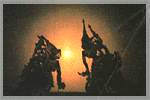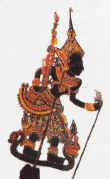|
'Wayang Kulit' or shadow play is an old cultural entertainment using shadows cast by intricately carved puppets in relaying mythical parables of good versus evil. |
|
|
The puppets are made of cow leather (kulit) that has been stretched and dried. The patterns are then carved out, hand painted and held on banana stems. Good characters will appear on the right side of the stage while evil characters, on the left. Behind the screen, backlit by a flickering oil lamp, the dalang (puppet master) will weave his tale, bringing to live the shadow play. |
| Moral values are easier to absorb in the form of parables, which is why wayang kulit flourished in the kampungs. |
Not everyone can be a dalang or puppet master. It takes skill to handle the puppets with both hands, sing and tap the kechrek (rattle) with one's foot to signal the musicians and to change the tone of one's voice to suit the various characters. |
|
| The Malay culture is a confluence of cultures, as such the wayang kulit not only depicts scenes from the Hindu epics such as the Ramayana and the Mahabhrata, but also merges Kelantanese folklore with elements from the Ramayana. In 1990, the conservative Islamic Pas government in the state of Kelantan prohibited wayang kulit performances on the grounds that the storylines and some rituals are non-Islamic and such shows are limited to only tourists in Kelantan. Sadly due to the ban, the dalang from Kelantan can no longer support themselves and are forced to work as menial labourers. What was once prized knowledge handed down from generation to generation is slowly slipping away before our very eyes. |
Tours
 Discover Malaysia States of Malaysia History Monarch Government History People Culture Festivals Holidays Handicrafts Cuisine Weather Golfing FAQ |
|



